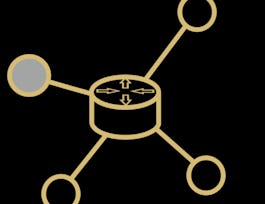"Introduction to Systems Engineering" uses a structured yet flexible approach to provide a holistic, solid foundation to the successful development of complicated systems.



Introduction to Systems Engineering


Instructors: Kumudu Amarawardhana
Sponsored by Barbados NTI
77,802 already enrolled
(795 reviews)
Details to know

Add to your LinkedIn profile
11 assignments
See how employees at top companies are mastering in-demand skills


Earn a career certificate
Add this credential to your LinkedIn profile, resume, or CV
Share it on social media and in your performance review

There are 9 modules in this course
Welcome to 'Introduction to Systems Engineering'! To help you in getting started with this course, we have a course introduction video that will provide you with an overview of the course syllabus.We then begin the course with this introductory module in which we address the nature of systems and the concept of a system life cycle. We identify what is meant when we say that something is a system and we narrow down the very broad definitions to focus on the human-made or modified systems that are our focus in systems engineering. We then look at the broad phases and activities that a system moves through during its life cycle, from early identification of the need for the system, exploration of options, functional design, physical design, detailed design and development, construction and production, utilization and support and then, finally, retirement.
What's included
11 videos6 readings1 assignment1 peer review
In this module, we describe the discipline of systems engineering and outline its relevance and benefits. We introduce what we mean by the ‘systems engineering’ and provide a framework within which we can consider the major processes, activities, and artefacts throughout the remainder of the course. In doing so, it will have become evident to you that the systems engineering approach has a number of advantages, so we then examine in a little more detail the relevance and benefits of systems engineering.
What's included
9 videos3 readings1 assignment1 peer review
Before we look at the various systems engineering activities in more detail in forthcoming modules, in this module we look at what we mean when we refer to the ‘needs’ and ‘requirements’ for a system. We examine the needs and requirements views developed by business management, business operations, and systems designers. We will also consider in this module how we might go about developing a set of requirements—we call that process ‘requirements engineering’.
What's included
8 videos2 readings1 assignment1 peer review
In this module, we explore requirements engineering and the processes by which requirements are elicited and defined formally through a process called elaboration (which involves derivation and decomposition of lower-level requirements from their parent requirements). We also look in this module at some simple requirements engineering tools and illustrate how they might be useful to you. Finally, we examine the notion of traceability, which ensures that we know where each requirement comes from, what requirements are related to it, and what requirements were derived from it. At the end of this module, you should be prepared to attempt the mid-course exam.
What's included
7 videos3 readings3 assignments1 peer review
In this module we examine Conceptual Design, during which we investigate how business needs and requirements and stakeholder needs and requirements are translated into a system-level understanding of the requirements of our system. This understanding will tell us what the system needs to do, how well it needs to perform, and what other systems it needs to interact with in order to meet the stakeholder and business needs and requirements. We then look at the concept of system level synthesis where we make some high-level design decisions before reviewing our work in preparation of the core design effort normally associated with preliminary and detailed design.
What's included
7 videos2 readings1 assignment1 peer review
In this module we pick up from where we left off at the end of Conceptual Design and we start to make some more detailed design decisions. During preliminary design, we will look at identifying the various subsystems that will need to come together to form our system. What do these subsystems need to be able to do? How do they need to inter-relate? Can we source these subsystems off the shelf or do they need to be designed from the ground up? These are key questions of preliminary design. For the subsystems that need to be designed or modified, some level of detailed design will be required. We will look at detailed design process and talk about tools like prototyping and how these tools help to refine the detailed design.
What's included
7 videos2 readings1 assignment1 peer review
We now move onto the construction and production of the system based on the detailed design from the previous stage. During construction and production, we look at critical systems engineering activities such as configuration audits and system verification. The system then enters the utilisation phase where we explore how systems engineering may continue to be involved via modification and upgrade projects. We finish this section by looking briefly at some of the issues we face when trying to dispose of or retire systems that are no longer required.
What's included
6 videos2 readings1 assignment1 peer review
In this final module, we explore some of the key management issues that systems engineering must address in order to maintain balance and control across the systems engineering effort. We look specifically at issues such as verification and validation management, configuration management, technical risk management and the management of the technical review and audit program. We also explore some of the broad strategies that may be adopted when executing a systems engineering process. Whilst we have used what is generally referred to as a waterfall approach throughout the course to explain systems engineering, in this module we also briefly introduce alternatives such as incremental and evolutionary development. We conclude the module by emphasising the importance of planning throughout the systems engineering program and the development of a governing plan known as the systems engineering management plan or SEMP.
What's included
7 videos1 reading1 assignment
Having finished the modules, you are now in a position to complete the final exam covering Modules 6 to 9. Before you finish the course we also thought that you may be interested in knowing about the Master of Systems Engineering program offered by UNSW Canberra--all courses can be completed online at any time, and entry is available to those with any undergraduate degree and there are entry pathways available for those without a first degree.
What's included
2 videos1 assignment
Instructors


Why people choose Coursera for their career




Learner reviews
795 reviews
- 5 stars
77.86%
- 4 stars
17.73%
- 3 stars
2.51%
- 2 stars
0.62%
- 1 star
1.25%
Showing 3 of 795
Reviewed on Oct 13, 2019
This course strengthens my knowledge which I gained over my working experience. Certainly, this is good course to begin understanding about the Systems Engineering.
Reviewed on May 23, 2020
An excellent course to the introduction of Systems Engineering. This course can be helpful and act as a foundation course in preparing oneself for C-SEP (Systems Engineering Professional)
Reviewed on May 8, 2022
This course, on top of relevant work experience, helped me get a systems engineering job. It is an excellent introduction and has many relevant use cases for different systems engineering tools.
Recommended if you're interested in Physical Science and Engineering

University of Colorado System

Johns Hopkins University

Northeastern University

University of Colorado Boulder

Open new doors with Coursera Plus
Unlimited access to 10,000+ world-class courses, hands-on projects, and job-ready certificate programs - all included in your subscription
Advance your career with an online degree
Earn a degree from world-class universities - 100% online
Join over 3,400 global companies that choose Coursera for Business
Upskill your employees to excel in the digital economy


